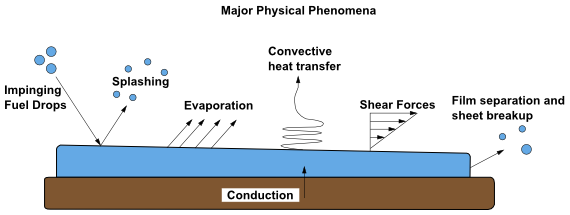Ansys Fluent has a specific boundary condition for simulation of liquid droplets colliding with walls and forming thin films. This model is particularly aimed at simulation of internal combustion engines. The Lagrangian wall film model uses transient Lagrangian particles to discretize physical effects and is therefore well suited for fast transient effects. Besides this, an Eulerian wall film model exists that is able to deal with steady wall films (Eulerian Wall Films).
Spray-wall interaction is an important part of the mixture formation process in port fuel injected (PFI) engines. A fuel spray impinges on a surface, usually at the intake port near the intake valve, as well as at the intake valve itself, where it splashes and subsequently evaporates. The evaporated mixture is entrained into the cylinder of the engine, where it is mixed with the fresh charge and any residual gas in the cylinder. The mixture that is compressed and burned, finally exits through the exhaust port. The process repeats itself between 200 and 8000 times per minute, depending on the engine.
Several cycles worth of fuel remain in the intake tract due to film formation on the walls. This in turn makes the film important in hydrocarbon emissions for PFI engines. Additionally, film can form inside combustion chambers of direct injection (DI) types of engines. In a direct injection engine, fuel is injected directly into the combustion chamber, where the spray can impinge upon the piston if the injection event is early or late in the cycle. The modeling of the wall-film inside a DI engine, especially in diesel engines, is compounded by the presence of carbon deposits on the surfaces of the engine. This carbon deposit absorbs the liquid film as it impinges upon it. It is believed that the carbon deposits adsorb the fuel later in the cycle, however this phenomenon is very complex and is not well understood.
In addition, wall film formation is an important factor for the Selective Catalytic Reduction (SCR) after-treatment process. The SCR of oxides of nitrogen with ammonia is a well-established emission control technology for meeting stringent NOx emission standards across the world. SCR system designers face several technical challenges, such as ammonia slip, urea crystallization, low temperature deposits, and other potential pitfalls. By not including the physics of wall film formation in SCR predictive models, large errors can be introduced in the NOx conversion predictions.
Finally, wall film modeling plays an important role in gas turbine operation and cooling of electronics.
DPM particles are used to model the wall-film. The wall-film model in Ansys Fluent allows a liquid drop to impinge upon a boundary surface and form a thin film. The model can be broken down into four major subtopics: interaction during the initial impact with a wall boundary, subsequent tracking on surfaces, calculation of film variables, and coupling to the gas phase. Figure 12.7: Mechanisms of Splashing, Momentum, Heat and Mass Transfer for the Lagrangian Wall-Film schematically shows the basic mechanisms considered for the Lagrangian wall-film model.
The main assumptions and restrictions for the Lagrangian wall-film model are as follows:
The layer is thin, less than 500 microns in thickness. This limitation is due to the assumption of a linear velocity profile in the film.
The temperature in the film particles change relatively slowly so that an analytical integration scheme can be utilized.
Film particles are assumed to be in direct contact with the wall surface and the heat transfer from the wall to the film takes place by conduction.
The film temperature never exceeds the boiling temperature for the liquid.
If you want to model a spray impacting a very hot wall, the wall-jet model may be more appropriate as the assumption in the wall-jet impingement model is that there is a vapor layer underneath the drops that keeps them from making direct contact with the boundary surface. This may be a more accurate assumption for in-cylinder diesel computations at typical operating conditions.
For more information about using the Lagrangian wall-film model in Ansys Fluent, see Modeling Lagrangian Wall Films in the Fluent User's Guide.



